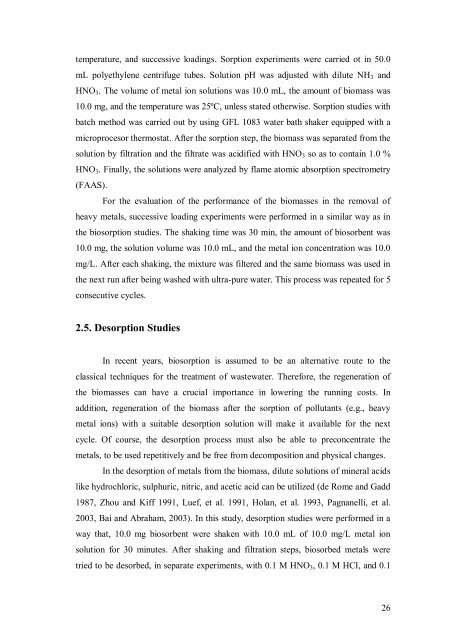BIOSORPTION OF Pb2+, Cd2+, & Ni2+ FROM WATERS BY ...
BIOSORPTION OF Pb2+, Cd2+, & Ni2+ FROM WATERS BY ...
BIOSORPTION OF Pb2+, Cd2+, & Ni2+ FROM WATERS BY ...
Create successful ePaper yourself
Turn your PDF publications into a flip-book with our unique Google optimized e-Paper software.
temperature, and successive loadings. Sorption experiments were carried ot in 50.0<br />
mL polyethylene centrifuge tubes. Solution pH was adjusted with dilute NH3 and<br />
HNO3. The volume of metal ion solutions was 10.0 mL, the amount of biomass was<br />
10.0 mg, and the temperature was 25ºC, unless stated otherwise. Sorption studies with<br />
batch method was carried out by using GFL 1083 water bath shaker equipped with a<br />
microprocesor thermostat. After the sorption step, the biomass was separated from the<br />
solution by filtration and the filtrate was acidified with HNO3 so as to contain 1.0 %<br />
HNO3. Finally, the solutions were analyzed by flame atomic absorption spectrometry<br />
(FAAS).<br />
For the evaluation of the performance of the biomasses in the removal of<br />
heavy metals, successive loading experiments were performed in a similar way as in<br />
the biosorption studies. The shaking time was 30 min, the amount of biosorbent was<br />
10.0 mg, the solution volume was 10.0 mL, and the metal ion concentration was 10.0<br />
mg/L. After each shaking, the mixture was filtered and the same biomass was used in<br />
the next run after being washed with ultra-pure water. This process was repeated for 5<br />
consecutive cycles.<br />
2.5. Desorption Studies<br />
In recent years, biosorption is assumed to be an alternative route to the<br />
classical techniques for the treatment of wastewater. Therefore, the regeneration of<br />
the biomasses can have a crucial importance in lowering the running costs. In<br />
addition, regeneration of the biomass after the sorption of pollutants (e.g., heavy<br />
metal ions) with a suitable desorption solution will make it available for the next<br />
cycle. Of course, the desorption process must also be able to preconcentrate the<br />
metals, to be used repetitively and be free from decomposition and physical changes.<br />
In the desorption of metals from the biomass, dilute solutions of mineral acids<br />
like hydrochloric, sulphuric, nitric, and acetic acid can be utilized (de Rome and Gadd<br />
1987, Zhou and Kiff 1991, Luef, et al. 1991, Holan, et al. 1993, Pagnanelli, et al.<br />
2003, Bai and Abraham, 2003). In this study, desorption studies were performed in a<br />
way that, 10.0 mg biosorbent were shaken with 10.0 mL of 10.0 mg/L metal ion<br />
solution for 30 minutes. After shaking and filtration steps, biosorbed metals were<br />
tried to be desorbed, in separate experiments, with 0.1 M HNO3, 0.1 M HCI, and 0.1<br />
26

















